| Haliotis Temporal range: | |
|---|---|
 | |
| Living abalone in tank showing epipodium and tentacles, anterior end to the right. | |
| Scientific classification | |
| Domain: | Eukaryota |
| Kingdom: | Animalia |
| Phylum: | Mollusca |
| Class: | Gastropoda |
| Subclass: | Vetigastropoda |
| Order: | Lepetellida |
| Superfamily: | Haliotoidea |
| Family: | Haliotidae Rafinesque, 1815 |
| Genus: | Haliotis Linnaeus, 1758 |
| Type species | |
| Haliotis asinina | |
| Synonyms[2] | |
| |
Haliotis, common name abalone, is the only genus in the family Haliotidae.[2]
This genus once contained six subgenera. These subgenera have become alternate representations of Haliotis.[2] The genus consists of small to very large, edible, herbivorous sea snails, marine gastropod molluscs. The number of species recognized worldwide ranges between 30[3] and 130,[4] with over 230 species-level taxa described. The most comprehensive treatment of the family considers 56 species valid, with 18 additional subspecies.[5]
Other common names are ear shells, sea ears, and, rarely, muttonfish or muttonshells in parts of Australia, ormer in the UK, perlemoen in South Africa, and the Māori name for three species in New Zealand is pāua.[6]
Description

The shells of abalones have a low, open, spiral structure, and are characterized by having several open respiratory pores in a row near the shell's outer edge. The thick inner layer of the shell is composed of nacre, which in many species of abalone is highly iridescent, giving rise to a range of strong, changeable colors, which make the shells attractive to humans as decorative objects, in jewelry, and as a source of colorful mother-of-pearl.
The shell of abalones is convex, rounded to oval shape, and may be highly arched or very flattened. The shell of the majority of species is ear-shaped, presenting a small, flat spire and two to three whorls. The last whorl, known as the body whorl, is auriform, meaning that the shell resembles an ear, giving rise to the common name "ear shell". Haliotis asinina has a somewhat different shape, as it is more elongated and distended. The shell of Haliotis cracherodii cracherodii is also unusual as it has an ovate form, is imperforate, shows an exserted spire, and has prickly ribs.
A mantle cleft in the shell impresses a groove in the shell, in which are the row of holes (known as tremata), characteristic of the genus. These holes are respiratory apertures for venting water from the gills and for releasing sperm and eggs into the water column. They make up what is known as the selenizone which forms as the shell grows. This series of eight to 38 holes is near the anterior margin. Only a small number are generally open. The older holes are gradually sealed up as the shell grows and new holes form. Therefore, the number of tremata is not characteristic for the species. Each species has a number of open holes, between four and 10, in the selenizone. This number is not fixed and can vary within a species and between populations. Abalones have no operculum. The aperture of the shell is very wide and nacreous.
The exterior of the shell is striated and dull. The color of the shell is very variable from species to species, which may reflect the animal's diet.[6] The iridescent nacre that lines the inside of the shell varies in color from silvery white, to pink, red and green-red, to deep blue, green to purple.
The animal shows fimbriated head-lobes. The side-lobes are also fimbriated and cirrated. The rounded foot is very large. The radula has small median teeth, and the lateral teeth are single and beam-like. About 70 uncini are present, with denticulated hooks, the first four very large. The soft body is coiled around the columellar muscle, and its insertion, instead of being on the columella, is on the middle of the inner wall of the shell. The gills are symmetrical and both well developed.[7]
These snails cling solidly with their broad muscular foot to rocky surfaces at sublittoral depths, although some species such as Haliotis cracherodii used to be common in the intertidal zone. Abalones reach maturity at a relatively small size. Their fecundity is high and increases with their size (from 10,000 to 11 million eggs at a time). The spermatozoa are filiform and pointed at one end, and the anterior end is a rounded head.[8]
The larvae are lecithotrophic. The adults are herbivorous and feed with their rhipidoglossan radula on macroalgae, preferring red or brown algae. Sizes vary from 20 mm (0.79 in) (Haliotis pulcherrima) to 200 mm (7.9 in), while Haliotis rufescens is the largest of the genus at 12 in (30 cm).[9]
By weight, about one-third of the animal is edible meat, one-third is offal, and one-third is shell.
Structure and properties of the shell
The shell of the abalone is exceptionally strong and is made of microscopic calcium carbonate tiles stacked like bricks. Between the layers of tiles is a clingy protein substance. When the abalone shell is struck, the tiles slide instead of shattering and the protein stretches to absorb the energy of the blow. Material scientists around the world are studying this tiled structure for insight into stronger ceramic products such as body armor.[10] The dust created by grinding and cutting abalone shell is dangerous; appropriate safeguards must be taken to protect people from inhaling these particles. There is much discussion of this topic online.[11][12]
Species
The number of species that are recognized within the genus Haliotis has fluctuated over time, and depends on the source that is consulted. The number of recognized species ranges from 30[3] to 130.[4] This list finds a compromise using the "WoRMS" database, plus some species that have been added, for a total of 57.[2][13] The majority of abalone have not been evaluated for conservation status. Those that have been reviewed tend to show that the abalone in general is declining in numbers, and will need protection throughout the globe.
Extant species
| Species | Range | Conservation status |
|---|---|---|
| Haliotis alfredensis Bartsch, 1915[nb 1] | South Africa | DD IUCN |
| Haliotis arabiensis Owen, Regter & Van Laethem, 2016 | Off Yemen and Oman | NT IUCN |
| Haliotis asinina Linnaeus, 1758 | Philippines; Indonesia; Australia; Japan; Thailand; Vietnam | LC IUCN |
| Haliotis australis Gmelin, 1791 | New Zealand | LC IUCN |
| Haliotis brazieri Angas, 1869 | Eastern Australia | NT IUCN |
| Haliotis clathrata Reeve, 1846 | Seychelles; Comores; Madagascar; Mauritius; Kenya | LC IUCN |
| Haliotis coccoradiata Reeve, 1846 | Eastern Australia | LC IUCN |
| Haliotis corrugata Wood, 1828 | California, USA; Baja California, Mexico | CR IUCN, Species of Concern National Marine Fisheries Service;[16] Vulnerable (global) and imperiled (California) California Department of Fish and Wildlife[17] |
| Haliotis cracherodii Leach, 1814 | California, USA; Baja California, Mexico | CR IUCN, Vulnerable (Global, Nation: US, State: California) California Department of Fish and Wildlife;[17][18] Listed endangered National Marine Fisheries Service[19] |
| Haliotis cyclobates Péron & Lesueur, 1816 | Southern Australia | LC IUCN |
| Haliotis dalli Henderson, 1915 | Galapagos Islands, western Colombia | DD IUCN |
| Haliotis discus Reeve, 1846 | Japan; South Korea | EN IUCN |
| Haliotis dissona (Iredale, 1929) | Australia; New Caledonia | LC IUCN |
| Haliotis diversicolor Reeve, 1846 | Japan; Australia; Southeast Asia | DD IUCN |
| Haliotis drogini Owen & Reitz, 2012 | Cocos Island | VU IUCN |
| Haliotis elegans Koch & Philippi, 1844 | Western Australia | LC IUCN |
| Haliotis exigua Dunker, R.W., 1877 (synonym of H. diversicolor) | Japan | Not evaluated |
| Haliotis fatui Geiger, 1999 | Tonga Mariana Islands | DD IUCN |
| Haliotis fulgens Philippi, 1845 | California, USA; Baja California, Mexico | CR IUCN, Vulnerable (Global, State: California California Department of Fish and Wildlife);[17] Species of Concern NMFS[20] |
| Haliotis geigeri Owen, 2014 | São Tomé and Príncipe Islands | VU IUCN |
| Haliotis gigantea Gmelin, 1791 | Japan | EN IUCN |
| Haliotis glabra Gmelin, 1791 | Philippines; Vietnam | LC IUCN |
| Haliotis iris Gmelin, 1791 | New Zealand | LC IUCN |
| Haliotis jacnensis Reeve, 1846 | Japan; Nicobar Islands; Ryukyu Islands; Pacific Islands; | LC IUCN |
| Haliotis kamtschatkana Jonas, 1845 | Western North America | EN IUCN, Imperiled (Alaska, British Columbia), Vulnerable (global, US), critically imperiled (California);[17][21] Species of Concern NMFS[22] |
| Haliotis laevigata Donovan, 1808 | South Australia; Tasmania | VU IUCN |
| Haliotis madaka (Habe, 1977) | Japan; South Korea | EN IUCN |
| Haliotis mariae Wood, 1828 | Oman; Yemen | EN IUCN |
| Haliotis marmorata Linnaeus, 1758 | Liberia; Ivory Coast; Ghana | LC IUCN |
| Haliotis melculus (Iredale, 1927) | Australia (New South Wales, Queensland) | VU IUCN |
| Haliotis midae Linnaeus, 1758 | South Africa | EN IUCN |
| Haliotis mykonosensis Owen, Hanavan & Hall, 2001 | Greece; Turkey; Tunisia | LC IUCN |
| Haliotis ovina Gmelin, 1791 | Thailand; Vietnam; southern part of the Pacific Ocean; Andaman Islands; Maldives; Ryukyu Islands | LC IUCN |
| Haliotis papulata Reeve, 1846 | Australia; Papua New Guinea; Philippines; Sri Lanka; Thailand | LC IUCN |
| Haliotis parva Linnaeus, 1758 | South Africa; Angola | DD IUCN |
| Haliotis planata G. B. Sowerby II, 1882 | Ryukyu Islands; Sri Lanka; Indonesia; Fiji; Andaman Sea | LC IUCN |
| Haliotis pourtalesii Dall, 1881 | Eastern USA; Gulf of Mexico; Eastern South America; northern Colombia | DD IUCN |
| Haliotis pulcherrima Gmelin, 1791 | Polynesia | DD IUCN |
| Haliotis queketti E.A. Smith, 1910 | Eastern Africa | DD IUCN |
| Haliotis roei Gray, 1826 | Australia | NT IUCN |
| Haliotis rubiginosa Reeve, 1846 | Lord Howe Island | CR IUCN |
| Haliotis rubra Leach, 1814 | Southern and Eastern Australia | VU IUCN |
| Haliotis rufescens Swainson, 1822 | Western North America | CR IUCN, apparently secure (global, US); critically imperiled (Canada)[23] |
| Haliotis rugosa Lamarck, 1822 | South Africa; Madagascar; Mauritius; Red Sea | LC IUCN |
| Haliotis scalaris (Leach, 1814) | Southern and Western Australia | LC IUCN |
| Haliotis semiplicata Menke, 1843 | Western Australia | LC IUCN |
| Haliotis sorenseni Bartsch, 1940 | California, USA; Baja California, Mexico | CR IUCN, critically imperiled (global, US, California);[17][24] Endangered NMFS[25] |
| Haliotis spadicea Donovan, 1808 | South Africa | LC IUCN |
| Haliotis speciosa Reeve, 1846 (synonym of H. tuberculata) | Eastern South Africa | Not evaluated |
| Haliotis squamosa Gray, 1826 | Southern Madagascar | DD IUCN |
| Haliotis stomatiaeformis Reeve, 1846 | Malta; Sicily | VU IUCN |
| Haliotis supertexta Lischke, 1870 (synonym of H. diversicolor) | Japan; Sao Tome | Not evaluated |
| Haliotis thailandis Dekker & Patamakanthin, 2001 (synonym of H. papulata) | Andaman Sea | Not evaluated |
| Haliotis tuberculata Linnaeus, 1758 | Ireland (introduced); Channel Islands; Azores; Canary Islands; Madeira ; Brittany; Great Britain | VU IUCN |
| Haliotis unilateralis Lamarck, 1822 | Gulf of Aqaba; East Africa; Seychelles; | LC IUCN |
| Haliotis varia Linnaeus, 1758 | Mascarene Basin; Red Sea; Sri Lanka; Western Pacific; | LC IUCN |
| Haliotis virginea Gmelin, 1791 | New Zealand; Chatham Islands; Auckland Islands; Campbell Island | LC IUCN |
| Haliotis walallensis Stearns, 1899 | Western North America | CR IUCN |
_S01.jpg.webp) A dorsal view of a live ass's ear abalone, Haliotis asinina
A dorsal view of a live ass's ear abalone, Haliotis asinina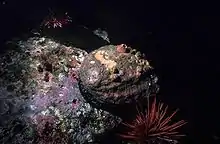 the pink abalone, Haliotis corrugata
the pink abalone, Haliotis corrugata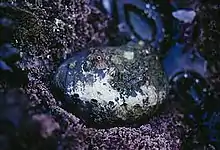 The black abalone, Haliotis cracherodii
The black abalone, Haliotis cracherodii Dorsal (left) and ventral (right) views of the blacklip abalone, Haliotis rubra
Dorsal (left) and ventral (right) views of the blacklip abalone, Haliotis rubra The white abalone, Haliotis sorenseni
The white abalone, Haliotis sorenseni A shell of Haliotis varia form dohrniana
A shell of Haliotis varia form dohrniana
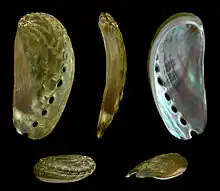
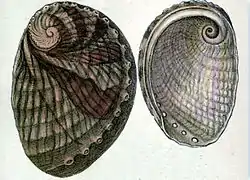
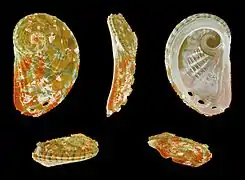

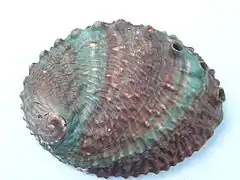

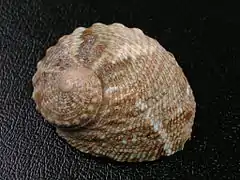
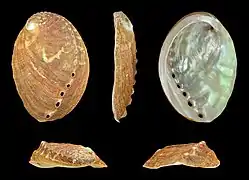 Haliotis discus discus
Haliotis discus discus
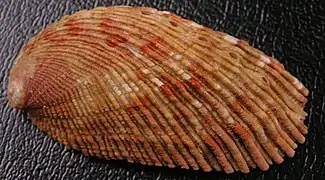
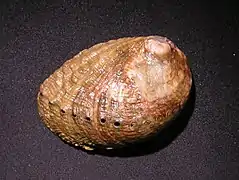
 Haliotis fulgens fulgens
Haliotis fulgens fulgens Haliotis gigantea f. sieboldii
Haliotis gigantea f. sieboldii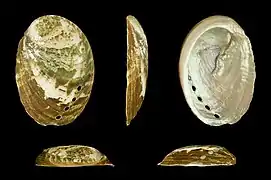


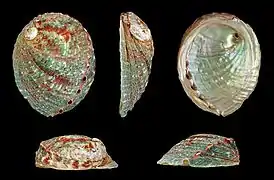 Haliotis kamtschatkana assimilis (South California).
Haliotis kamtschatkana assimilis (South California). Haliotis laevigata (South Australia).
Haliotis laevigata (South Australia).
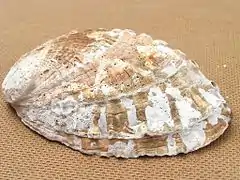


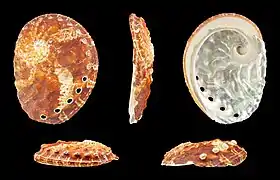
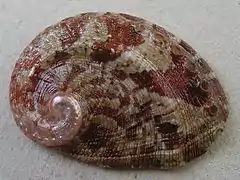
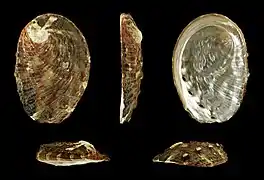
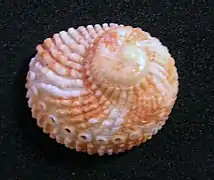
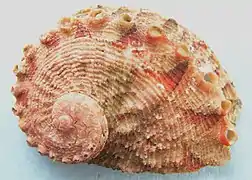
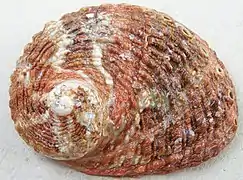


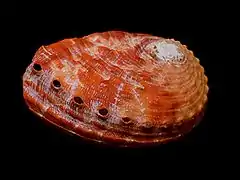
_(Quinn's_Rocks%252C_Western_Australia)_1_(23565526643).jpg.webp)

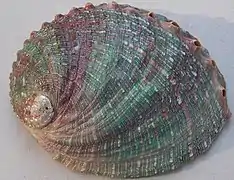
_(South_Africa)_3_(24139744761).jpg.webp)
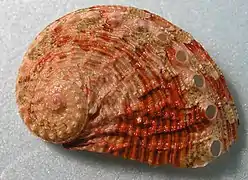
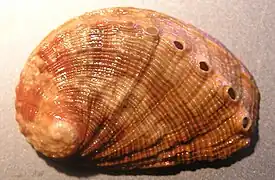

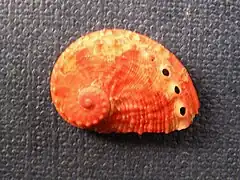
 Haliotis tuberculata (Europe)
Haliotis tuberculata (Europe)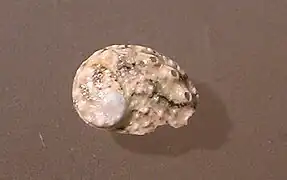
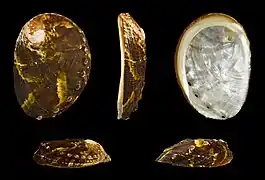


Fossil species
- †Haliotis benoisti Cossmann, 1896 (Aquitaine, France)
- †Haliotis flemingi Powell, 1938 (New Zealand)
- †Haliotis lomaensis Anderson, 1902
- †Haliotis mathesonensis (Eagle, 1996)
- †Haliotis (Marinauris) matihetihensis (Eagle, 1999)
- †Haliotis powelli C. A. Fleming, 1952
- †Haliotis stalennuyi Owen & Berschauer, 2017
- †Haliotis volhynica Eichwald, 1829
- †Haliotis waitemataensis Powell, 1938
Conservation
Over half of the modern Haliotis species with sufficient data are considered threatened to some extent on the IUCN Red List, with all but one species from the Pacific coast of North America being critically endangered as a consequence of massive historical overharvesting, withering abalone syndrome, and recent marine heatwaves which have caused collapses of both abalones and their habitat. Haliotis species from elsewhere are also threatened by overexploitation and climate change. In addition, abalones as a whole are considered highly vulnerable to ocean acidification due to their accretion of aragonite and dependence on susceptible coralline algae for development, and thus may eventually go extinct unless the rate of ocean acidification is arrested.[26][27][28][29]
Synonyms
See also
References
- ↑ Geiger & Groves 1999, p. 872
- 1 2 3 4 Gofas, Tran & Bouchet 2014
- 1 2 Dauphin et al. 1989, p. 9
- 1 2 Cox 1962, p. 8
- ↑ D.L., Geiger (1999). "Distribution and biogeography of the recent Haliotidae (Gastropoda: Vetigastropoda) world-wide". Bollettino Malacologico.
- 1 2 Beesley, Ross & Wells 1998
- ↑ Tryon 1880, p. 41
- ↑ Tryon 1880, p. 46
- ↑ Hoiberg 1993, p. 7
- ↑ Lin & Meyers 2005, p. 27 & 38
- ↑ Abalone Toxicity https://orchid.ganoksin.com/t/abalone-toxicity/9357/2
- ↑ Shell Dust Dangers https://www.banjohangout.org/archive/187285
- ↑ Abbott & Dance 2000
- ↑ Tran & Bouchet 2009
- ↑ EoL 2014
- ↑ Neuman 2007
- 1 2 3 4 5 State of California 2011
- ↑ Anon 2014f
- ↑ Anon 2009
- ↑ Neuman 2009
- ↑ Anon 2014c
- ↑ Gustafson & Rumsey 2007
- ↑ Anon 2014d
- ↑ Anon 2014e
- ↑ Anon 2001
- ↑ IUCN (2021-05-21). "Haliotis rufescens: Peters, H., Rogers-Bennett, L. & De Shields, R.M.: The IUCN Red List of Threatened Species 2021: e.T78771583A78772573". doi:10.2305/iucn.uk.2021-3.rlts.t78771583a78772573.en. S2CID 245151062.
{{cite journal}}: Cite journal requires|journal=(help) - ↑ Kerlin, Katherine E. (2022-12-12). "All West Coast Abalones at Risk of Extinction on the IUCN Red List". UC Davis. Retrieved 2022-12-24.
- ↑ "First-ever global Red List assessment of abalone underlines urgency of combatting illegal trade - Wildlife Trade News from TRAFFIC". www.traffic.org. Retrieved 2022-12-24.
- ↑ Byrne, Maria; Ho, Melanie; Wong, Eunice; Soars, Natalie A.; Selvakumaraswamy, Paulina; Shepard-Brennand, Hannah; Dworjanyn, Symon A.; Davis, Andrew R. (2010-12-22). "Unshelled abalone and corrupted urchins: development of marine calcifiers in a changing ocean". Proceedings of the Royal Society B: Biological Sciences. 278 (1716): 2376–2383. doi:10.1098/rspb.2010.2404. ISSN 0962-8452. PMC 3119014. PMID 21177689.
Notes
Sources
- Abbott, R. Tucker; Dance, S. Peter (2000). Compendium of Seashells (4th ed.). Odyssey Publishing. pp. 19–23. ISBN 978-0-9661720-0-3.
- Anon (2014c). "Haliotis kamtschatkana – Jonas, 1845". NatureServe Explorer. Archived from the original on 26 August 2014. Retrieved 22 August 2014.
- Anon (2014d). "Haliotis refescens – Swainson, 1822". NatureServe Explorer. Archived from the original on 26 August 2014. Retrieved 22 August 2014.
- Anon (2014e). "Haliotis sorenseni – Bartsch, 1940". NatureServe Explorer. Archived from the original on 26 August 2014. Retrieved 22 August 2014.
- Anon (2014f). "Haliotis cracherodii – Leach, 1814". NatureServe Explorer. Archived from the original on 26 August 2014. Retrieved 22 August 2014.
- Anon (14 January 2009). "Endangered and Threatened Species; Endangered Status for Black Abalone". Federal Register: The Daily Journal of the United States. Archived from the original on 26 August 2014. Retrieved 22 August 2014.
- Anon (29 May 2001). "Endangered and Threatened Species; Endangered Status for White Abalone". Federal Register: The Daily Journal of the United States. Archived from the original on 29 July 2014. Retrieved 22 August 2014.
- Beesley, P. L.; Ross, G. J. B.; Wells, A. (1998). Mollusca: The Southern Synthesis: An Essential Reference. Melbourne, Australia: CSIRO Publishing. pp. 667–669. ISBN 978-0-643-05756-2.
- Cox, Keith W. (1962). "California abalone, family Haliotidae". The Resources Agency of California Department of Fish and Game: Fish Bulletin. 118. ISSN 6306-2593.
- Dauphin, Y.; Cuif, J. P.; Mutvei, H.; Denis, A. (1989). "Mineralogy, Chemistry and Ultrastructure of the External Shell-layer in Ten Species of Haliotis With Reference to Haliotis tuberculata (Mollusca, Archaeogastropoda)". Bulletin of the Geological Institutions of the University of Uppsala. 15: 7–38. ISSN 0302-2749.
- EoL (2014). "Haliotis speciosa: Splendid Abalone". Encyclopedia of Life. Archived from the original on 21 August 2014. Retrieved 21 August 2014.
- Geiger, Daniel L.; Groves, Lindsey T. (September 1999). "Review of Fossil Abalone (Gastropoda, Vetigastropoda, Haliotidae) with Comparison to Recent Species". Journal of Paleontology. 73 (5): 872–885. doi:10.1017/S0022336000040713. ISSN 0022-3360. S2CID 87537607.
- Gofas, Serge; Tran, Bastien; Bouchet, Phillippe (2014). "WoRms Taxon Details: Haliotis Linnaeus, 1758". WoRMS (World Register of Marine Species). Archived from the original on 10 October 2014. Retrieved 16 August 2014.
- Gustafson, Rick; Rumsey, Scott (1 November 2007). "Species of Concern: Pinto Abalone Haliotis Kamtschatkana" (PDF). NOAA: National Marine Fisheries Service. Archived (PDF) from the original on 7 October 2012. Retrieved 22 August 2014.
- Hoiberg, Dale H., ed. (1993). "The New Encyclopaedia Britannica". Encyclopædia Britannica. Vol. 1: A-ak Bayes (15th ed.). Chicago, IL: Encyclopædia Britannica, Inc. ISBN 978-0-85229-961-6. LCCN 2002113989.
- Lin, Albert; Meyers, Marc André (15 January 2005). "Growth and Structure in Abalone Shell". Materials Science and Engineering: A. 390 (1–2): 27–41. doi:10.1016/j.msea.2004.06.072. ISSN 0921-5093.
- Neuman, Melissa (10 June 2009). "Species of Concern: Green Abalone Haliotis fulgens" (PDF). NOAA: National Marine Fisheries Service. Archived (PDF) from the original on 4 March 2016. Retrieved 22 August 2014.
- Neuman, Melissa (2 November 2007). "Species of Concern: Pink Abalone Haliotis corrugata" (PDF). NOAA: National Marine Fisheries Service. Archived (PDF) from the original on 4 March 2016. Retrieved 22 August 2014.
- State of California (January 2011). "Special Animals (898 Taxa)" (PDF). State of California: Division of Fish and Game. Archived from the original (PDF) on 24 January 2014. Retrieved 22 August 2014.
- Tran, Bastien; Bouchet, Phillippe (2009). "WoRMS Taxon Details: Haliotis corrugata oweni Talmadge, 1966". WoRMS: World Register of Marine Species. Archived from the original on 17 October 2014. Retrieved 19 August 2014.
- Linnaeus, C. 1758. Systema Naturae per Regna tria Naturae, secundem Classes, Ordines, Genera, Species, cum Characteribus, Differentis, Synonymis, Locis. Tom.1 Editio decima, reformata. Holmiae : Laurentii Salvii 824 pp.
- Iredale, T. 1927. Caloundra Shells. The Australian Zoologist 4: 331–336, pl. 46
- Iredale, T. 1929. Queensland molluscan notes, No. 1. Memoirs of the Queensland Museum 9(3): 261–297, pls 30-31
- Cotton, B.C. & Godfrey, F.K. 1933. South Australian Shells. Part 9. South Australian Naturalist 15(1): 14-24
- Cotton, B.C. 1943. Australian Shells of the Family Haliotidae. Transactions of the Royal Society of South Australia 67(1): 175-180
- Moore, R.C. (ed.) 1960. Treatise on Invertebrate Paleontology. Part I. Mollusca 1. Boulder, Colorado & Lawrence, Kansas : Geological Society of America & University of Kansas Press xxiii + 351 pp.
- Wilson, B. 1993. Australian Marine Shells. Prosobranch Gastropods. Kallaroo, Western Australia : Odyssey Publishing Vol. 1 408 pp.
- Geiger, D.L. & Poppe, G.T. 2000. A Conchological Iconography. The family Haliotidae. Germany : ConchBooks 135 pp.
- Bouchet, P.; Gofas, S. (2014). Haliotis Linnaeus, 1758. Accessed through: World Register of Marine Species
- Tryon, George W. Jr. (1880). Manual of Conchology; Structural and Systematic With Illustrations of the Species (PDF). Vol. II: Muricinæ, Purpurinæ. Philadelphia, PA: Academy of Natural Sciences.